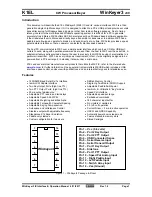
UG-1262
Rev. B | Page 162 of 312
where:
V(s)
is the signal voltage.
I(s)
CAL
is the calibration current.
Z
CAL
(magnitude)
is the magnitude of the impedance of the calibration.
Therefore,
( )
( )
CAL
V s
I s
Z
(11)
In Step 2,
02
02
( )
( )
RE
RLOAD
RE
RLOAD
V s
I s
Z
(12)
where:
Z
RE + RLOAD02
is the impedance of the sensor and Load Resistor 2.
I(s)
RE + RLOAD02
is the current flowing through the sensor and Load Resistor 2.
Therefore,
02
02
( )
( )
RE
RLOAD
RE
RLOAD
V s
Z
I s
(13)
In Step 3,
02
02
( )
( )
RLOAD
RLOAD
V s
I s
Z
(14)
where:
Z
RLOAD02
is the impedance of Load Resistor 2.
I(s)
RLOAD02
is the current flowing through Load Resistor 2.
Therefore,
02
02
( )
( )
RLOAD
RLOAD
V s
Z
I s
(15)
Therefore, based on Step 2 through Step 4,
02
02
02
02
02
02
02
02
02
02
( )
( )
( )
( )
1
1
( )
( )
( )
( )
( )
( )
( )
( )
RE
RE RLOAD
RLOAD
RE RLOAD
RLOAD
CAL
CAL
RE RLOAD
RLOAD
RLOAD
RE RLOAD
CAL
CAL
RE RLOAD
RLOAD
V s
V s
Z
Z
Z
I s
I s
I s
Z
I s
I s
I s
I s
I s
Z
I s
I s
(16)
If Z
CAL
(magnitude) = 200 Ω and Z
CAL
(phase) = 0, it is possible to obtain the following equations:
02
02
02
02
02
02
( )
( )
(
)
200
( )
( )
( )
RLOAD
RE RLOAD
RE
RE RLOAD
RLOAD
CAL
RE RLOAD
RLOAD
I s
I s
Z
magnitude
Z
Z
I s
I s
I s
(17)
where:
Z
RE
(magnitude)
is the magnitude of the impedance of the sensor.
I(s)
values can be replaced by DFT results.
02
02
02
02
02
02
(
)
( )
( )
( )
( )
( )
(
)
Ang
0
Ang
Ang
Ang
Ang
RE RLOAD
RLOAD
CAL
RLOAD
RE RLOAD
RE RLOAD
RLOAD
RE
Z
Z
I s
I s
I s
I s
I s
Z
phase
(18)
where:
Z
RE
(phase)
is the phase part of the impedance measurement of the sensor.
Ang() is the function to calculate phase.















































